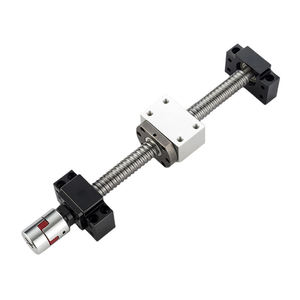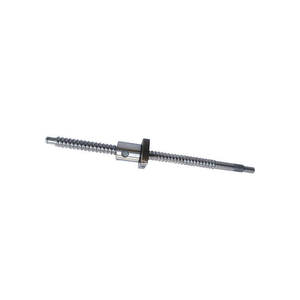(1619 products available)



























































































































































































































A 16mm lead screw is a type of screw that converts rotational motion into linear motion. The lead screw consists of the screw thread itself and may have a specific nut used for it. Lead screws are made in different configurations and can vary widely in their materials, coatings, and sizes. The following variants are ideal for industrial machinery.
16mm lead screw with nut
Without the nut, the lead screw would not provide the necessary resistance to create motion. Therefore, it is essential to pick up the right combination of lead and nut, both of which should be tailored to the application at hand. Lead screws come with nuts in various configurations. The nut not only creates the motion by resisting the lead screw but also ensures that the system is efficient and free of backlash. The lead screw nut assembly usually transmits power and motion from rotational movement to linear force.
Self-locking lead screw
Self-locking lead screws are designed to hold position without the need for constant motor power. These screws are ideal for applications where energy efficiency, enhanced safety, and precise positioning are paramount. Lead screws often feature a unique thread design that provides friction locking, thus preventing unintended movement.
Ball screw
A 16mm ball screw differs from a lead screw in that it employs ball bearings to reduce friction between the nut and screw shaft. Ball screws offer high levels of efficiency and precision. Their operating principle is based on the rolling of the balls, which are housed inside the nut, between the screw shaft and the nut itself. The first motion is then converted to the second motion with high efficiency by the relatively low friction between the screw and the nut. Ball screws are most suitable for applications that require high accuracy, like machine tools and automation equipment.
16mm lead screws are widely used in many applications and industries because they are reliable, cost-effective, and easy to source. Some examples of how lead screws are used include the following:
When looking for lead screws for assembly, always consider the application's requirements. The size, accuracy, and robustness will also matter in the assembly. It's best to note the specific parameters and performance needed before making a purchase.
When choosing the size, make sure that there is enough clearance for the part to function well. It is also a good idea to consider any possible noise from the lead screw working inside the machinery. If noise is a major concern, choose a lead screw that has a finer pitch.
Take note of the load capacity needed in the application. Choose a lead screw that is rated for the load capacity while offering good energy efficiency. With this, the assembly can work without any problems. It's also a good idea to choose a lead screw that can be serviced easily. This means lubrication is easy to do, and the exposure of the lead screw to dirt or debris is minimal.
For precision applications, it's best to use a lead screw with a higher accuracy class. This can ensure better performance in the system. The robustness of the lead screw is also important. Make sure that the chosen lead screw has sufficient strength to resist bending and buckling in the assembly.
It will be a good idea to select lead screws with various diameters and lengths to find the best one for the application. Working with suppliers that have a good reputation can give buyers the confidence to choose the best lead screw for their individual needs.
Q1: Is a 16mm lead screw stronger than a 10mm lead screw?
A1: Yes. The strength of a lead screw depends on its size, including the diameter. The 16mm lead screw has a larger diameter than the 10mm lead screw, which gives it greater strength and load-bearing capacity.
Q2: What material is suitable for a 16mm lead screw?
A2: Most 16mm lead screw manufacturers use carbon steel or stainless steel. Stainless steel has the advantage of being rust-free. In addition, plastic, such as PVC, is another common material used for 3D printer lead screws.
Q3: What is the difference between a 16mm lead screw and a 16mm lead screw nut?
A3: The lead screw is the threaded rod that converts rotational motion into linear motion. On the other hand, the lead screw nut is a sliding block that runs along the lead screw. Together, they form a mechanism for movement.